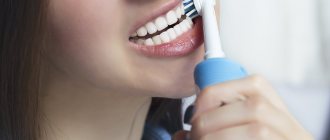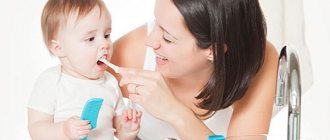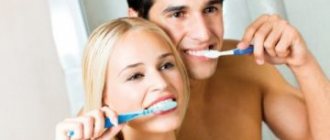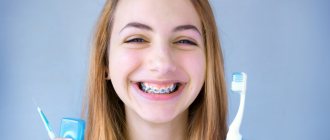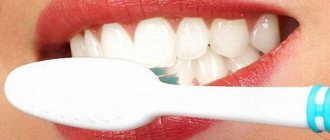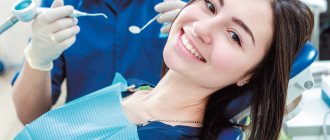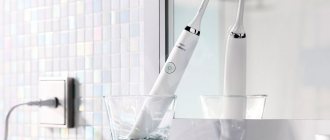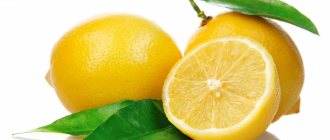Author of the article:
Soldatova Lyudmila Nikolaevna
Candidate of Medical Sciences, Professor of the Department of Clinical Dentistry of the St. Petersburg Medical and Social Institute, Chief Physician of the Alfa-Dent Dental Clinic, St. Petersburg
Brushing your teeth is the main method of hygienic oral care; Without it, neither rinses, nor dental floss, nor even regular visits to the dentist will save you from caries and other diseases that threaten tooth destruction and damage to gum and periodontal tissue. Residues of food stuck in interdental spaces, periodontal pockets and other hard-to-reach areas of the oral cavity become a breeding ground for bacteria, and also provoke the appearance of an unpleasant odor as a result of decomposition. In addition, acids and other caustic substances contained in food can also have a destructive effect on enamel and dentin.
How often should you brush your teeth? Most doctors recommend brushing at least twice a day; You should especially carefully clean in the evening, before going to bed, since it is at night that the most active proliferation of pathogenic bacteria occurs, which are the main cause of caries, stomatitis and most other dental diseases. However, some experts believe that teeth should be cleaned after every meal.
How to brush your teeth? Cleaning Techniques
Proper brushing of teeth includes several stages, each of which is aimed at cleaning one of the surfaces of the teeth, as well as various parts of the oral cavity. For adults, the correct sequence of actions is as follows:
- With your mouth wide open, clean the outer surfaces of your teeth using sweeping movements from the gums to the cutting edge. This must be done with both the upper and lower jaw.
- Do the same on the inside of your teeth. When cleaning your front teeth, turn the head of the toothbrush across the teeth rather than along them.
- Clean the chewing surfaces of your teeth with vigorous horizontal movements.
- To remove plaque and food debris more thoroughly, brush in a circular motion.
- Clean your tongue using the special pad on the back of the toothbrush head or using the bristles itself. You need to move from the root of the tongue forward. Do not press too hard on the root of the tongue, as this may cause vomiting.
- It is recommended to end the evening brushing with a light massage of the gums - to do this, make circular movements with your mouth closed. If you have inflammation or bleeding gums, or enlarged gum pockets, you should avoid this.
- After brushing is completed, the interdental spaces should be cleaned using dental floss. To do this, take a piece of thread 40-50 centimeters long, wrap it around your middle or index fingers and carefully insert it between your teeth, making several movements back and forth. Unwind the floss gradually, cleaning each gap with a fresh section and avoiding putting too much pressure on the gum edge. Flosses are also recommended to be used after each meal to remove food debris from the interdental space.
- The final stage is rinsing your mouth with warm or cold water and washing your brush. For additional protection against unpleasant odors and bacteria, you can use a mouthwash such as ASEPTA Fresh, which contains witch hazel, sage and chamomile extracts that can eliminate inflammation and unpleasant odors.
Step-by-step instruction
Cleansing takes 3 minutes! Particular attention should be paid to hard-to-reach areas: gum line, interdental spaces.
Cleaning scheme:
- Wet the brush with warm water.
- Apply the paste in a thin strip to the brush.
- Start cleansing from the upper jaw. First, treat the outer molars and chewing teeth behind the cheeks.
- The direction of movement is from left to right. If you are left-handed, it is better to start on the right.
- The basic rule of the technique is to place the brush parallel to the gums.
- Do not press too hard on the brush.
- Movements are circular, brush each area for 10 seconds. During this time, make 10 movements with the brush.
- Then start brushing from the gums to the bottom edges.
- Next, treat the inner surfaces in the same way.
- Clean your tongue and inner cheeks.
- Rinse your mouth, changing the water 3 times.
Don’t forget to wash your brush and treat it with an antiseptic after each procedure.
How to properly brush your teeth with toothpicks?
Doctors do not recommend frequent use of toothpicks, as they can injure the gums. However, if you don’t have floss on hand, you can carefully use a toothpick, following these recommendations:
- Do not use force when cleaning the interdental space from food particles;
- Do not make sudden movements;
- Try to maintain a 45-degree angle when using a toothpick;
- The direction of movement should be from the gum to the sharp edge of the tooth;
- It is recommended to apply only light pressure so that the toothpick does not break during the process.
How to care for braces?
In order to properly brush your teeth with braces, you need to follow these tips:
- For cleaning you will need 2 brushes, one of which should be tuft-shaped and the other should have a V-shape. The first is intended to clean the front teeth, the second – the back teeth.
- It is necessary to use fluoride-containing paste.
- Brushing your teeth must be done after every meal.
For clarity, you can find on the Internet and watch a video on how to properly brush your teeth if you have braces in your mouth.
Professional hygiene
If the plaque has already turned into stone, only a dentist can remove it. At the same time, it is not possible to completely remove plaque even if you follow all the rules for brushing your teeth. Therefore, everyone who cares about their dental health is recommended to visit the dentist twice a year and have their teeth professionally cleaned. In advanced cases, gingivitis also forms, a painful inflammation of the gums.
What does professional oral hygiene include?
The first stage of oral care in the dental office is diagnosis and analysis of existing problems. Based on these, procedures are prescribed, which most often include cleaning plaque and stone (if necessary, with anesthesia).
Pigmented plaque is cleaned with a special Air Flow apparatus, which operates using a jet stream of aerosol containing sodium bicarbonate.
In modern dental clinics, ultrasound is used during cleaning, which removes soft and hard deposits from the enamel. In this case, the teeth are not damaged, plaque and stone are gently peeled off from visible surfaces.
The next stage is the treatment of intergingival spaces. This is a manual procedure that requires care and professionalism from the dentist.
After the stone is removed, the enamel is polished to protect it from bacteria. This is done using polishing pastes and special brushes and rubber bands.
Professional cleaning ends with the application of fluoride-containing varnish to the enamel, which provides additional protection and makes teeth less sensitive. The price of such a procedure depends on many factors, but you should not skimp on dental health.
Daily cleaning rules
Teeth should be brushed 2 times a day. Morning cleansing should be done before meals, and evening cleansing should be done after. It is not recommended to carry out this procedure more than 2 times to avoid abrasion of tooth enamel. After each meal, you can use a rinse or floss.
The recommended duration of the oral hygiene procedure is 3-5 minutes. During a given period of time, a person manages to make the optimal number of cleaning movements, sufficient to completely get rid of food debris, accumulated plaque and microorganisms.
What is proper oral hygiene
The goal of proper personal oral hygiene is to make your teeth healthier, your breath fresh and pleasant, and to prevent bleeding gums and the formation of yellow plaque. As a result of proper care, your smile will become attractive and snow-white, and the main result is the prevention of dental diseases.
Proper nutrition is also very important. For example, apples strengthen enamel.
There are several indicators of proper and effective oral hygiene:
- clean teeth without stuck pieces of food;
- pink gums that do not hurt or bleed when brushing;
- no bad breath;
- There is no pain when chewing food.
If the condition of your teeth does not correspond to at least one of these signs, you need to contact your dentist. If necessary, he will provide treatment and give advice on oral care, recommend suitable toothbrushes and pastes, and point out problem areas.
Mistakes when brushing teeth and their consequences
Main mistakes and their consequences:
- Infrequent or insufficiently long brushing can lead to the formation and accumulation of a large amount of plaque. Over time, inflammatory processes will begin to occur in the oral cavity, leading to the destruction of enamel and causing caries.
- Brushing too often can not only damage and thin the enamel, but also lead to bleeding gums.
- Horizontal rather than vertical cleaning techniques eventually lead to the destruction of the upper layers of enamel. However, using an exclusively vertical technique can result in plaque being concentrated in the interdental space.
- If you do not use dental floss, food debris will accumulate in the interdental space, which, together with harmful bacteria, will lead to the process of decay and, as a result, the formation of caries.
- If you do not wash and dry the brush after use, plaque particles and bacteria will remain on it. During the next brushing, microorganisms will again enter the oral cavity.
- Rinse your teeth with tap water. Running water contains many impurities that negatively affect the condition of the enamel and can neutralize the beneficial effects of the toothpaste components on the teeth.
Which pasta should you choose?
To brush your teeth, a toothbrush is not enough; you need to choose the right toothpaste. First, it prevents scratching of enamel and gum surfaces, softening the impact of stubble and increasing user comfort. Secondly, good pastes, due to special components and abrasives, soften and mechanically remove plaque, making it easier to remove with a brush. Thirdly, they contain substances that help strengthen enamel, prevent bleeding gums, and have a therapeutic effect on the oral cavity.
A paste with a strengthening effect should contain fluoride; people with sensitive gums are usually prescribed pastes with anti-inflammatory components. For those who do not have dental problems, hygienic pastes are suitable - they do not have a therapeutic effect, but only help remove plaque and deodorize the oral cavity to ensure fresh breath.
Properly brush your teeth with a toothbrush and a small amount of toothpaste. For adults, 1 cm is enough per cleaning, for children 4-6 years old - one pea, and for children 2-3 years old - an amount of paste the size of a grain of rice. Too much paste should not be used because an excess of active ingredients can harm the teeth. In particular, excess fluoride can lead to the development of a pathological condition such as fluorosis, in which dark spots and streaks appear on the teeth.
Additional recommendations
When brushing, you should not put too much pressure on the brush, especially if you use a brush with medium or maximum hardness bristles - this can lead to damage to the mucous membranes and enamel, and even to the development of a serious pathology - wedge-shaped tooth defect. You should not use too much toothpaste.
To check the quality of cleaning, run your tongue over your teeth: they should be perfectly smooth, without the slightest roughness. You can also purchase staining tablets at the pharmacy that will help identify poorly cleaned areas of tooth enamel.
In addition, it is necessary to pay sufficient attention to the choice of toothbrush and toothpaste. These are two of the best tools for cleaning your teeth and mouth from food debris and harmful bacteria.
It must be remembered that replacing a toothbrush must occur in a timely manner - at least once every 3 months, otherwise a worn-out product with bristles damaged over time will not cope with its task effectively enough.
Don't use chewing gum as a substitute for brushing. Despite the proven benefits of this process, chewing gum cannot completely replace mechanical cleansing, in addition, it is significantly less effective in combating bacteria.
If you use a shared bathroom, use a special case, not a cup holder, to store brushes, since when you flush the toilet, bacteria spread within a radius of 2 meters and can land on the brush.
We hope that our recommendations for brushing your teeth will be useful to you and that your teeth will always delight you with whiteness. And so that their cleaning is more effective. Try Asepta PLUS Remineralization professional toothpaste. This unique product restores tooth enamel, reduces the sensitivity of teeth and gums and accelerates the regeneration of the oral mucosa.
Choosing a toothpaste
Almost all pastes are therapeutic and prophylactic. Serve for mechanical cleansing and help prevent caries, periodontitis, and periodontal disease. To do this, the composition includes various components that should be taken into account when choosing a care product:
- Fluorides and calcium. Included in the composition for the prevention of caries and restoration of enamel structure.
- Medicinal plants, essential oils, antiseptic substances (chlorhexidine, triclosan). Eliminate bleeding, swelling of the gums, remove plaque.
- Potassium, strontium, aminofluoride, hydroxyapatite. Reduce tissue sensitivity and relieve pain.
- Enzymes (papain) and antimicrobial substances (lysozyme, lactoferrin, lactoperoxidase). Added to whitening pastes to increase the effectiveness of plaque removal.
- Vitamin complex (A, E, C, B, carotoline). Improves metabolic processes, accelerates the healing of the mucous membrane.
You need to choose a paste depending on your existing dental problems. Don't get carried away with fluoride-containing toothpastes. If there is an excess of fluoride, fluorosis can develop. Therefore, fluoride-containing toothpastes are used no more than once a day.
Clinical researches
Clinical studies have proven that regular use of professional toothpaste ASEPTA REMINERALIZATION improved the condition of the enamel by 64% and reduced tooth sensitivity by 66% after just 4 weeks.
Sources:
- Report on the determination/confirmation of the preventive properties of personal oral hygiene products “ASEPTA PLUS” Remineralization doctor-researcher A.A. Leontyev, head Department of Preventive Dentistry, Doctor of Medical Sciences, Professor S.B. Ulitovsky First St. Petersburg State Medical University named after. acad. I.P. Pavlova, Department of Preventive Dentistry
- Evaluation of the clinical effectiveness of a combined drug of local etiotropic action in the treatment of inflammatory periodontal diseases (E.L. Kalichkina, E.A. Tyo, Z.Z. Abubakarova) E.L. Kalichkina, candidate of medical sciences, assistant of the department of therapeutic dentistry, Kemerovo State Medical Academy of Roszdrav, Kemerovo E.A. Tyo, MD, professor, head of the department of therapeutic dentistry, Kemerovo State Medical Academy of Roszdrav, Kemerovo Abubakarova, assistant of the department of therapeutic dentistry, Kemerovo State Medical Academy of Roszdrav, Kemerovo GOU HPE Kemerovo State Medical Academy of Roszdrav , Kemerovo
- Clinical and laboratory assessment of the influence of domestic therapeutic and prophylactic toothpaste based on plant extracts on the condition of the oral cavity in patients with simple marginal gingivitis. Doctor of Medical Sciences, Professor Elovikova T.M.1, Candidate of Chemical Sciences, Associate Professor Ermishina E.Yu. 2, Doctor of Technical Sciences Associate Professor Belokonova N.A. 2 Department of Therapeutic Dentistry USMU1, Department of General Chemistry USMU2
How to remove plaque at home
The effectiveness of traditional methods depends on the thickness and density of the accumulated layer. If the deposits have appeared recently and are moderately soft, it is enough to clean them in the usual way using a brush.
When yellowish or dark pigmentation appears on the enamel, harder bristles and products with abrasives (Lacalut White, Rembrandt “Anti-tobacco and coffee”, etc.) come to the rescue. However, such compositions should be used only after consulting a dentist and with his approval. By scratching the enamel, you can significantly worsen the condition of your incisors, canines and molars, causing caries and more serious oral diseases.
The patient should simultaneously receive answers to two questions from the doctor:
- how to clean your teeth from plaque at home so that it is quick, painless, but effective;
- what mixtures and solutions to use for safe cleansing without negative consequences.
Many patients use improvised components that have been highly effective for many years. One of the most popular is activated carbon. The tablets are crushed with a spoon or mortar to obtain fine-grained particles that remove deposits and polish the surface. A damp brush is dipped into the resulting powder, after which standard cleaning is performed for several minutes. After using the drug, you should rinse your mouth thoroughly with water. To prevent increased sensitivity, this method cannot be used more than 2-3 times a week.
Baking soda is also often used. The procedure is exactly the same as in the previous case. In the same way, it is indicated to use industrial tooth powder.
Essential oils (lemon, tea tree) are also highly effective. This is the safest home option since there is no exposure to abrasives. There are several ways to use these compounds:
- add 4 drops of oily liquid to a glass of warm water, rinse your mouth after your usual regular brushing;
- drop onto the brush before cleansing without paste.
But do not rush to use advice without recommendations from a dentist.
